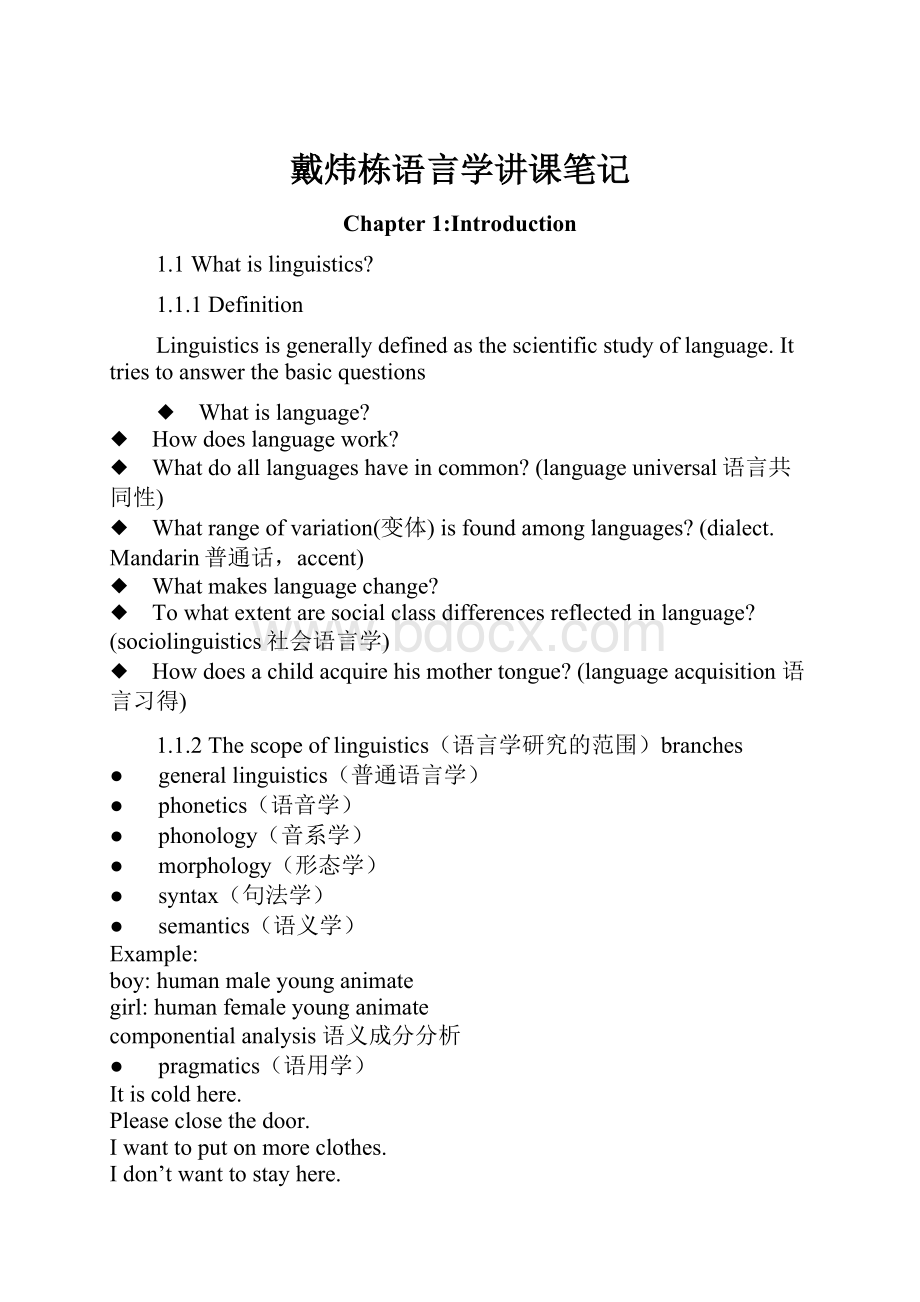戴炜栋语言学讲课笔记.docx
《戴炜栋语言学讲课笔记.docx》由会员分享,可在线阅读,更多相关《戴炜栋语言学讲课笔记.docx(58页珍藏版)》请在冰豆网上搜索。

戴炜栋语言学讲课笔记
Chapter1:
Introduction
1.1Whatislinguistics?
1.1.1Definition
Linguisticsisgenerallydefinedasthescientificstudyoflanguage.Ittriestoanswerthebasicquestions
◆ Whatislanguage?
◆ Howdoeslanguagework?
◆ Whatdoalllanguageshaveincommon?
(languageuniversal语言共同性)
◆ Whatrangeofvariation(变体)isfoundamonglanguages?
(dialect.Mandarin普通话,accent)
◆ Whatmakeslanguagechange?
◆ Towhatextentaresocialclassdifferencesreflectedinlanguage?
(sociolinguistics社会语言学)
◆ Howdoesachildacquirehismothertongue?
(languageacquisition语言习得)
1.1.2Thescopeoflinguistics(语言学研究的范围)branches
● generallinguistics(普通语言学)
● phonetics(语音学)
● phonology(音系学)
● morphology(形态学)
● syntax(句法学)
● semantics(语义学)
Example:
boy:
humanmaleyounganimate
girl:
humanfemaleyounganimate
componentialanalysis语义成分分析
● pragmatics(语用学)
Itiscoldhere.
Pleaseclosethedoor.
Iwanttoputonmoreclothes.
Idon’twanttostayhere.
● sociolinguistics(社会语言学)
● psycholinguistics(心理语言学)
● appliedlinguistics(应用语言学)
broadsense:
广义,
narrowsense:
狭义=languageteaching
1.1.3Someimportantdistinctionsinlinguistics(语言学中一些重要的概念区分)
1.1.3.1Prescriptivevs.descriptive(规定与描写)
Ifalinguisticstudyaimstodescribeandanalyzethelanguagepeopleactuallyuse,itissaidtobedescriptive;
Ifthelinguisticstudyaimstolaydown(规定)rulesfor"correctandstandard"behaviourinusinglanguage,i.e.totellpeoplewhattheyshouldsayandwhattheyshouldnotsay,itissaidtobeprescriptive.
1.1.3.2Synchronic(共时语言学)vs.diachronic(历时语言学)
● Thedescriptionofalanguageatsomepointoftimeinhistoryisasynchronicstudy.
● Thedescriptionofalanguageasitchangesthroughtimeisadiachronicstudy.Adiachronicstudyoflanguageisahistoricalstudy;itstudiesthehistoricaldevelopmentoflanguageoveraperiodoftime.
1.1.3.3Speechandwriting(言语与文字)
Speechandwritingarethetwomajormediaoflinguisticcommunication.Modernlinguisticsregardsthespokenlanguageasthenaturalortheprimarymediumofhumanlanguageforsomeobviousreasons.Fromthepointofviewoflinguisticevolution,speechispriortowriting.Thewritingsystemofanylanguageisalways"invented"byitsuserstorecordspeechwhentheneedarises.Evenintoday'sworldtherearestillmanylanguagesthatcanonlybespokenbutnotwritten.
1.1.3.4Langueandparole(语言与言语)
Languereferstotheabstractlinguisticsystemsharedbyallthemembersofaspeechcommunity.(语言社区)
Parolereferstotherealizationoflangueinactualuse.(actualuseoflanguage,concrete)
Differences:
1.Langueisabstract;itisnotthelanguagepeopleactuallyuse.Paroleisconcrete;itreferstothenaturallyoccurringlanguageevents.(语言事件)
2.Langueisrelativelystable,itdoesnotchangefrequently;whileparolevariesfrompersontoperson,andfromsituationtosituation.(Saussure索绪尔)
1.1.3.5Competenceandperformance(语言能力和语言运用)
competenceandperformance,
Chomsky(乔姆斯基)(aprof.atMIT)definescompetence(langue)astheidealuser'sknowledgeoftherulesofhislanguage,andperformance(parole)theactualrealizationofthisknowledgeinlinguisticcommunication.
WhileSaussure'sdistinctionandChomsky'sareverysimilar,theydifferatleastinthatSaussuretookasociologicalviewoflanguageandhisnotionoflangueisamatterofsocialconventions,andChomskylooksatlanguagefromapsychologicalpointofviewandtohimcompetenceisapropertyofthemindofeachindividual.
1.1.3.6Traditionalgrammarandmodernlinguistics(传统语法与现代语言学)
《普通语言学教程》Saussure索绪尔
Thedifferences:
Firstly,linguisticsisdescriptivewhiletraditionalgrammarisprescriptive.
Second,modernlinguisticsregardsthespokenlanguageasprimary,notthewritten.
Then,modernlinguisticsdiffersfromtraditionalgrammaralsointhatitdoesnotforcelanguagesintoaLatin-basedframeworkofthelanguagesusedbymankind.
1.2Whatislanguage?
1.2.1Definitionsoflanguage
◆ "Languageisapurelyhumanandnon-instinctivemethodofcommunicatingideas,emotionsanddesiresbymeansofvoluntarilyproducedsymbols."(Sapir,1921)
◆ Languageis"theinstitutionwherebyhumanscommunicateandinteractwitheachotherbymeansofhabituallyusedoral-auditoryarbitrarysymbols."(Hall,1968)
◆ "FromnowonIwillconsiderlanguagetobeaset(finiteorinfinite)ofsentences,eachfiniteinlengthandconstructedoutofafinitesetofelements."(Chomsky,1957)
◆ Languageisasystemofarbitrary(任意的)vocalsymbolsusedforhumancommunication.
Firstofall,languageisasystem,i.e.,elementsoflanguagearecombinedaccordingtorules.
Second,languageisarbitrary(任意的)inthesensethatthereisnointrinsic(天生的,内在的)connectionbetweenalinguisticsymbolandwhatthesymbolstandsfor,forinstance,betweentheword"pen"andthethingwewritewith.
(ThisconventionalnatureoflanguageiswellillustratedbyafamousquotationfromShakespeare'splay"RomeoandJuliet":
"Arosebyanyothernamewouldsmellassweet.")
Third,languageisvocalbecausetheprimarymediumforalllanguagesissound.
Theterm"human"inthedefinitionismeanttospecifythatlanguageishuman-specific,i.e.,itisverydifferentfromthecommunicationsystemsotherformsoflifepossess,suchasbirdsongsandbeedances.
1.2.2Designfeatures(识别特征)
1) Arbitrariness(任意性)
2)Productivity(多产性)
3)Duality(二重性)
4)Displacement(移位)
5)Culturaltransmission(文化传递)
-Chapter1
-Chapter2
-Chapter3
-Chapter4
-Chapter5
-Chapter6
-Chapter7
-Chapter8
-Chapter9
-Chapter10
Chapter2:
Phonology
2.1Thephonicmediumoflanguage(语言的语音媒介)
Speechandwritingarethetwomediaorsubstancesusedbynaturallanguagesasvehiclesforcommunication.Manylanguagesintheworldtodayarebothwrittenandspoken.Butstatisticsresultingfromcarefulinvestigationsshowthattherehavebeenover5,000languagesintheworld,abouttwothirdsofwhichhavenothadwrittenform.
Ofthetwomediaoflanguage,speechismorebasicthanwritingforreasonsthatwerediscussedinthelastchapter.Thewritingsystemofanylanguageisalways"invented"byitsuserstorecordspeechwhentheneedarises.
Languageisfirstperceivedthroughitssounds.Thusthestudyofsoundsisofgreatimportanceinlinguistics.Naturally,linguistsarenotinterestedinallsounds;theyareconcernedonlywiththosesoundsthatareproducedbyhumansthroughtheirspeechorgansandhavearoletoplayinlinguisticcommunication.Thesesoundsarelimitedinnumber.Thislimitedrangeofsoundswhicharemeaningfulinhumancommunicationconstitutethephonicmediumoflanguage(语言的语音媒介);andtheindividualsoundswithinthisrangearethespeechsounds(言语语音).
2.2Phonetics(语音学)
2.2.1Whatisphonetics?
Phoneticsisdefinedasthestudyofthephonicmediumoflanguage;itisconcernedwithallthesoundsthatoccurintheworld'slanguages.
Phoneticslooksatspeechsoundsfromthreedistinctbutrelatedpointsofview.
First,itstudiesthesoundsfromthespeaker'spointofview,i.e.,howaspeakeruseshisspeechorganstoarticulatethesounds.Then,itlooksatthesoundsfromthehearer'spointofview,i.e.,howthesoundsareperceivedbythehearer.Lastly,itstudiesthewaysoundstravelbylookingatthesoundwaves,thephysicalmeansbywhichsoundsaretransmittedthroughtheairfromonepersontoanother.Thesethreebranchesofphoneticsarelabelledarticulatoryphonetics(发音语音学),auditoryphonetics(听觉语音学),andacousticphonetics(声学语音学)respectively.
Ofthethreebranchesofphonetics,articulatoryphoneticshasthelongesthistory.However,someimportantfactshavealsobeeneitherdiscoveredorconfirmedbyacousticandauditoryphonetics,especiallybytheformer.Acousticphoneticianstrytodescribethephysicalpropertiesofthestreamofsoundswhichaspeakerissues.Todescribetheseproperties,theyrecordthesoundwavesonmachinescalledspectrographs(频谱仪).Bystudyingthesoundwavesthusrecorded,theyhavediscoveredthatwhatmightbeheardasthesameoneutteranceisonlycoincidentally,ifever,physicallyidentical.The"same"soundsweclaimtohaveheardareinmostcasesonlyphoneticallysimilar,butrarelyphoneticallyidentical.Phoneticsimilarity,notphoneticidentityisthecriterionwithwhichweoperateinthephonologicalanalysisoflanguages.
2.2.2Organsofspeech(发音器官)
Thearticulatoryapparatusofahumanbeingarecontainedinthreeimportantareas:
thepharyngealcavity(咽腔)--thethroat,theoralcavity(口腔)-themouth,andthenasalcavity(鼻腔)--thenose.Theairstreamcomingfromthelungsmaybemodifiedinthesecavitiesinvariousways.Itmayalsobemodifiedinthelarynxbeforeitreachesanyofthecavities.Suchmodificationresultsfromsomekindofinterferencewiththemovementoftheairstream.Theprincipalsourceofsuchmodificationsisthetongue,andtheword"language"itselfderivesfromtheLatinword"lingua",meaningthe"tongue".ThepharyngealcavityAircomingfromthelungsandthroughthewindpipepassesthroughtheglottis,apartofthelarynx,whichisabonystructureattheendofthewindpipe.Thisisthefirstpointwheresoundmodificationmightoccur.Lyingacrosstheglottisarethevocalcords.Thesetwothintissuescanbeheldtightlytogethertocutoffthestreamofair,aswhenoneis'holdinghisbreath'.Theycanberelaxedandfoldedbackateachsidetoletairflowthroughfreelyandsilentlyasinnormalbreathing.Thentheymayalsobeheldtogethertautlysothattheairstreamvibratesthematdifferentspeedswhenforcingits